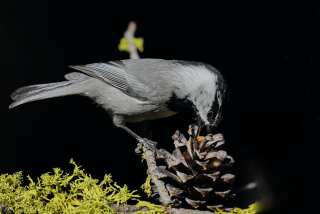Cicadas liven up Staten Island with song and sex
- Share via
NEW YORK — There are bugs in the trees. There are bugs on the shrubs, on screen doors, on barbecue grills, on front steps. There are shells of bugs on the ground, crunchy as tempura, and bug bodies clinging onto leaves, their dead orange eyes still beady.
There is a large live bug on John Kempf’s collar, and a dead one in his 6-year-old son Aren’s hand. Neither seems to mind.
“I love them; it’s nature,” said Kempf, a Staten Island resident who recently collected 300 bugs in a cooler to bring to his yard, in the hope they would multiply. “It’s only once in 17 years. You have to enjoy it while they’re here.”
He is describing Brood II, a population of the cicada species that descends on parts of the East Coast every 17 years. The bugs emerge to emit a high-pitched screech that sounds a bit like a malfunctioning white noise machine, to mate with abandon and then to die, leaving their eggs on twigs that fall to the ground, allowing tiny nymphs to crawl into dirt holes and live another 17 years, when the cycle repeats.
Though Brood II sightings have stretched from North Carolina to Connecticut, the insects aren’t found much in New York City, except for Staten Island. That allows the city’s least-populated borough to spend a few weeks in the spotlight, if a weird one.
It is estimated that, during the short time the cicadas are above ground, there are about 600 bugs to every human on Staten Island. On some blocks, the noise rises above the whir of air conditioners, the blare of radios and the screams of small children who don’t like insects.
Most of the time, Ed Johnson, director of science at the Staten Island Museum, has to be content with the 35,000 dead cicadas kept there (the second-largest cicada collection in the world). But for a brief few weeks this summer, he gets to lead cicada tours, hold cicada parties, plan cicada movie festivals, and even eat cicadas, coated in flour and panko, then pan fried.
On one such cicada walk through a boggy Staten Island woodland teeming with bugs, dead and alive, he stops at a clearing to appreciate their short — three weeks, maybe — adult lives.
“We have a pair of mating cicadas on this plant over here,” he shouts back to the dozens of hapless New Yorkers following him through the mud to observe the bugs. The mating cicadas look like a two-headed mutant.
As he speaks, one cicada lands on a tour participant’s ear and another flies at a small child’s head. It is a bit like being in a warped Disney movie, where instead of bluebirds on one’s shoulder there are flying black-and-brown bugs with orange eyes.
Fun facts: Cicadas can breed for 96 hours straight. Sometimes they give up after one. Little is known about what they do for the 17 years they live underground, except that they eat tree sap. They are much more interesting above ground, or at least easier to study.
“It’s one hell of a party for two weeks,” says Lawrence Gall, a cicada expert at Yale University.
The pilgrims thought that cicadas were locusts, like in the Bible. Thoreau wrote about them in a letter to his mother. People passing Staten Island on tall ships in the 19th century could hear their mating calls as they sailed by.
The bugs have their fans. They include Greg Plowman of Manhattan, who, using the guilt trip of Father’s Day, lured his wife and son and son’s friend to the cicada walk on Staten Island. Plowman, a scientist, has a dead cicada in the bug collection in his study, but he’s enamored of the live ones too.
“Let me know if you find one with white eyes,” he instructs his son, camera in hand. “Those are rare.”
His son, Max, a teenager, is not impressed. (Though it is possible he’s not easily impressed. He was wearing a black shirt that refers to quantum physics theory.)
“It’s not worth it,” Max says of the life of a Magicicada septendecim. “They exist to turn tree sap into noise.”
Indeed, the cicada’s odd span can invoke questions about the meaning of life in the most improbable ways.
“It’s like Liam Neeson said in that Star Wars movie: In the course of nature, there’s always something bigger than you,” says Dan Dellaratta, picking up trash in a Staten Island park where birds are having a cicada feast. (The bugs taste delicious to animals. Humans seem to need to add lots of salt.)
Dellaratta claims that six bugs coordinated an attack on him, five distracting him while one went in for a bite. If only he had a truckful of cats or birds, he says, he’d unleash them on the bugs.
“A noise like that, it isn’t like a woman calling you for breakfast or something. It’s like the sound of a war cry,” he says. “It’s like some crazy movie.”
Of course, now that the bugs are well into the cycle of mating, laying their eggs and dying, people like Ray Matarazzo, whose home in Great Kills, Staten Island, is infested with the bugs, have something new to deal with.
Matarazzo loves the bugs, even if he has had to sweep them off his stairs for the last few weeks to avoid crunching them. He looks twice before he sits anywhere outside, as sitting on cicadas is not pleasant.
Now, their corpses are beginning to pile up. The smell — well, Matarazzo likens it to that of a dirty, wet dog.
“It’s just decomposition,” he says, hopefully. “The ants and bacteria will break them down eventually. I just hope that happens soon.”
More to Read
Sign up for Essential California
The most important California stories and recommendations in your inbox every morning.
You may occasionally receive promotional content from the Los Angeles Times.














